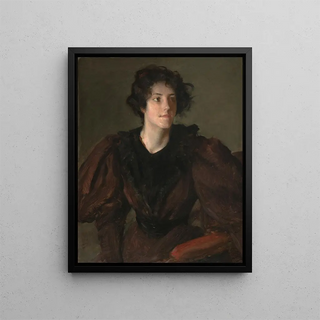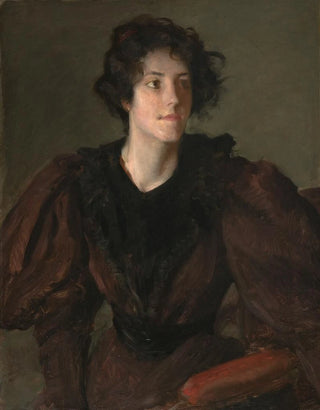Art print | Study of a young woman (Case of conflict) - William Merritt Chase Source: Reproduction | Étude d'une jeune femme (Conflit de cas) - William Merritt Chase


View from behind

Frame (optional)
In the vast panorama of art history, some works stand out for their ability to capture the very essence of humanity. "Study of a Young Woman (Conflict of Cases) - William Merritt Chase" is one of those masterpieces that, through its apparent simplicity, reveals emotional depth and fascinating psychological complexity. This canvas, which showcases Chase's undeniable talent for portraiture, invites the viewer to immerse themselves in a world where each brushstroke tells a story. The young woman depicted appears both vulnerable and strong, reflecting internal struggles that everyone can experience, making this work a mirror of the human soul.
Style and uniqueness of the work
Chase's work is characterized by an impressionist style that skillfully blends light and color. In "Study of a Young Woman (Conflict of Cases)", delicate nuances of the young woman's skin, as well as the fluidity of the drapery, demonstrate exceptional mastery of pictorial technique. Chase uses vibrant color touches to create shadows and highlights, thus bringing his subject to life. The composition, though simple, is highly effective, with a blurred background that highlights the expressive face of the protagonist. This artistic choice emphasizes the tension between the individual and their environment, reinforcing the idea of internal conflict that inhabits the young woman. This portrait does not merely depict a figure; it evokes an atmosphere, an emotion, a moment frozen in time.
The artist and his influence
William Merritt Chase, an emblematic figure of the American impressionist movement, mastered the art of blending tradition and innovation throughout his career. Trained at the Munich Academy of Fine Arts, he developed a unique style that influenced many contemporary artists. His ability to capture authentic emotions and play with light paved the way for new artistic explorations. Chase was also a pioneer in art education, sharing his passion and knowledge with his students, some of whom became renowned artists in their own right. Through "Study of a

Matte finish

View from behind

Frame (optional)
In the vast panorama of art history, some works stand out for their ability to capture the very essence of humanity. "Study of a Young Woman (Conflict of Cases) - William Merritt Chase" is one of those masterpieces that, through its apparent simplicity, reveals emotional depth and fascinating psychological complexity. This canvas, which showcases Chase's undeniable talent for portraiture, invites the viewer to immerse themselves in a world where each brushstroke tells a story. The young woman depicted appears both vulnerable and strong, reflecting internal struggles that everyone can experience, making this work a mirror of the human soul.
Style and uniqueness of the work
Chase's work is characterized by an impressionist style that skillfully blends light and color. In "Study of a Young Woman (Conflict of Cases)", delicate nuances of the young woman's skin, as well as the fluidity of the drapery, demonstrate exceptional mastery of pictorial technique. Chase uses vibrant color touches to create shadows and highlights, thus bringing his subject to life. The composition, though simple, is highly effective, with a blurred background that highlights the expressive face of the protagonist. This artistic choice emphasizes the tension between the individual and their environment, reinforcing the idea of internal conflict that inhabits the young woman. This portrait does not merely depict a figure; it evokes an atmosphere, an emotion, a moment frozen in time.
The artist and his influence
William Merritt Chase, an emblematic figure of the American impressionist movement, mastered the art of blending tradition and innovation throughout his career. Trained at the Munich Academy of Fine Arts, he developed a unique style that influenced many contemporary artists. His ability to capture authentic emotions and play with light paved the way for new artistic explorations. Chase was also a pioneer in art education, sharing his passion and knowledge with his students, some of whom became renowned artists in their own right. Through "Study of a






